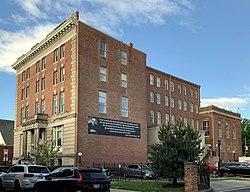Description and history
The Thurgood Marshall Center is located on the west side of 12th Street NW, between S and T Streets. It is a large rectangular four-story masonry building, built out of red brick with trim of limestone and gray brick. Its main facade is three bays wide, with a center entrance sheltered by a Tuscan portico with entablature, modillioned cornice, and low balustrade above. The ground floor is finished in bands of gray brick arranged to appear as rough stone, while the upper floors are red brick with gray brick corner quoining. Limestone stringcourses serve as a water table between the basement and first floor, between the first and second floors, and above the top floor. The building is crowned by a modillioned and dentillated cornice and a low balustrade. Windows are set in pairs in each bay, with limestone keystones. [1]
The international YMCA was founded in Great Britain in 1844, and its first American branch opened in 1851. Anthony Bowen founded the first African-American branch of the organization in 1853 in Washington, one year after a branch for whites was opened in the city. The organization struggled financially in its early years, and was not formally incorporated until 1892. The organization moved into its first permanent home on 11th Street in 1891, which soon after had to be sold due to declining membership. After a membership drive revitalized the organization, it secured a pledge from John D. Rockefeller Sr. for $25,000, which was matched by fundraising from across the nation's African-American community. It is believed to be the first such campaign of its type in that community. This building was completed in 1912 to a design by African-American architect William Sidney Pittman. [1]
In 1973 Twelfth Street YMCA was officially renamed Anthony Bowen YMCA in honor of its founder. It closed in 1982, suffering from declining membership and mounting building maintenance costs. [1] Politicians Washington DC Congressional Delegate Walter E Fauntroy and Washington D.C Mayor Marion Barry lead several protest demanding the reopening due to its historical significance. [5] In 1983, the building was nominated as Historic Landmark [6] but not until 1989 that Congressional Delegate Walter Fauntroy introduced to Congress the bill to designate the Anthony Bowen Landmark Building (formerly the Anthony Bowen Y.M.C.A.) in Washington, the District of Columbia as a national historic site, [7] declaring this historic building National Historic Landmark on October 12, 1994. [8]
The restoration of the building started with Walter Fauntroy's plan to improve opportunities for neighborhood youth in the Shaw community. In 1983, in coordination with Real Estate developer George T. Farrell, Walter Fauntroy fully restored the building and adapted it for the use of the community by providing a full service health and recreational facility administered by the YMCA. The renovation spurred increased gentrification of the Shaw community from a low income enclave to a young urban professional locale bringing a surprising change for the current residents. The Antony Bowen YMCA operated as a community recreation center with gymnasium and library until it was again renovated to become the Thurgood Marshall Community Center under direction of the Thurgood Marshal Center Trust, Incorporated. [9]
This page is based on this
Wikipedia article Text is available under the
CC BY-SA 4.0 license; additional terms may apply.
Images, videos and audio are available under their respective licenses.


